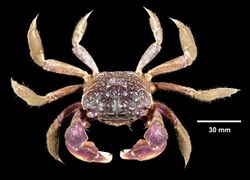Biology:Sesarma reticulatum
| Sesarma reticulatum | |
|---|---|

| |
| Scientific classification | |
| Domain: | Eukaryota |
| Kingdom: | Animalia |
| Phylum: | Arthropoda |
| Class: | Malacostraca |
| Order: | Decapoda |
| Suborder: | Pleocyemata |
| Infraorder: | Brachyura |
| Family: | Sesarmidae |
| Genus: | Sesarma |
| Species: | S. reticulatum
|
| Binomial name | |
| Sesarma reticulatum (Say, 1817)[1]
| |
Sesarma reticulatum, the purple marsh crab or simply marsh crab, is a crab species native to the salt marshes of the eastern United States.
Distribution
The range of S. reticulatum extends from Woods Hole, Massachusetts to Volusia County, Florida; a related species occurs in the Gulf of Mexico.[2]
Description
Sesarma reticulatum is purple or brown, with darker speckles, with a carapace up to 1 inch (25 mm) long.[3] It can be distinguished from the closely related S. cinereum by the presence of a second tooth around the orbit of each eye.[4]
The larvae or zoea of Sesarma reticulatum are aquatic, residing at a depth of greater than 1 meter below the water's surface.[5] The larvae remain in estuaries during their development, providing food for predators.[6]
Ecology
Their overpopulation, caused by over-harvesting by recreational fishermen of its natural predators such as blue crabs, striped bass, smooth dogfish and cod, has been blamed for the decline in cordgrass found in the salt marshes of Cape Cod and the decrease in the extent of salt marshes on the Atlantic coast of North America due to increased erosion. Scientists from Brown and Princeton universities methodically ruled out other causes for the degradation of the salt marshes.[7] The explosion in the population of sesarma crabs has provided additional food to night herons. The crabs eat marsh grass not only from above but underground in tunnels they construct. The research demonstrates the possible cumulative ecological impact of popular human activities such as recreational fishing.[8][9]
References
- ↑ Peter Davie (2011). "Sesarma reticulatum (Say, 1817)". WoRMS. World Register of Marine Species. http://www.marinespecies.org/aphia.php?p=taxdetails&id=158458.
- ↑ Todd L. Zimmerman; Darryl L. Felder (1991). "Reproductive ecology of an intertidal brachyuran crab, Sesarma sp. (nr. reticulatum), from the Gulf of Mexico". The Biological Bulletin 181 (3): 387–401. doi:10.2307/1542359. PMID 29304676. http://www.biolbull.org/content/181/3/387.full.pdf.
- ↑ Richard E. Mulstay (1999). "Marsh crabs". in Eugene H. Kaplan. A Field Guide to Southeastern and Caribbean Seashores: Cape Hatteras to the Gulf Coast, Florida, and the Caribbean (2nd ed.). Houghton Mifflin Harcourt. ISBN 978-0-395-97516-9. https://books.google.com/books?id=Ekfhub2YU5EC&pg=PA330.
- ↑ Susan B. Rothschild (2004). "Life in the marsh debris". Beachcomber's Guide to Gulf Coast Marine Life: Texas, Louisiana, Mississippi, Alabama, and Florida (3rd ed.). Taylor Trade Publications. p. 68. ISBN 978-1-58979-061-2. https://books.google.com/books?id=w0hWmtbRNwIC&pg=PA68.
- ↑ Hovel, Kevin A.; Morgan, Steven G. (1999). "Susceptibility of estuarine crab larvae to ultraviolet radiation". Journal of Experimental Marine Biology and Ecology 237: 107–125. doi:10.1016/S0022-0981(98)00221-4. https://www.sciencedirect.com/science/article/pii/S0022098198002214.
- ↑ Morgan, Steven G. (1990). "Impact of Planktivorous Fishes on Dispersal, Hatching, and Morphology of Estuarine Crab Larvae". Ecology 71 (5): 1639–1652. doi:10.2307/1937574. http://www.escholarship.org/uc/item/03s4c6vw.
- ↑ Bertness, M. D.; Brisson, C. P.; Coverdale, T. C.; Bevil, M. C.; Crotty, S. M.; Suglia, E. R. (2014). "Experimental predator removal causes rapid salt marsh die-off". Ecology Letters 17 (7): 830–835. doi:10.1111/ele.12287. PMID 24766277.
- ↑ Richard C. Lewis (November 19, 2007). "Cape salt marsh decline linked to native crab". The Boston Globe. http://www.boston.com/news/science/articles/2007/11/19/cape_salt_marsh_decline_linked_to_native_crab/.
- ↑ Mark D. Bertness; Andrew H. Altieri; Tyler C. Coverdale; Nicholas C. Herrmann; Christine Angelini (2012). "A trophic cascade triggers collapse of a salt marsh ecosystem with intensive recreational fishing". Ecology 93 (6): 1402–1410. doi:10.1890/11-1314.1. PMID 22834380.
Wikidata ☰ Q6497242 entry
 |

